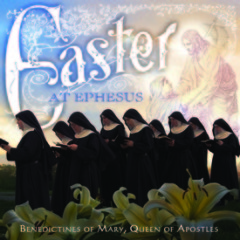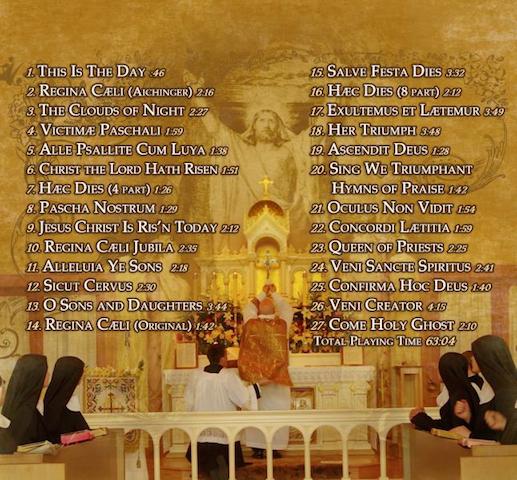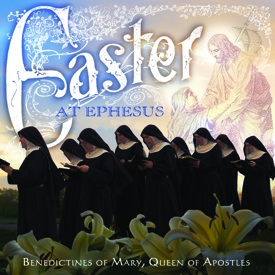

EASTER AT EPHESUS
Benedictines of Mary, Queen of Apostles
DeMontfort Music
The young order (formed in 1995) of contemplative nuns based in Missouri and known as the Benedictines of Mary, Queen of Apostles quietly continue releasing new albums and asserting itself as the #1 selling Billboard Classical Traditional Artist for, now, three consecutive years (2012-2014). The sisters’ repertoire—mostly centuries old with a new original song dropped in here and there—is a meditative antidote to the vulgarity, gimmickry and moral and aesthetic bankruptcy of much of contemporary music. The latest example of this spiritually elevating music comes in the form of Easter at Ephesus, the order’s fourth major release. Once again produced by now-11-time Grammy winning producer Christopher Alder, the sisters offer stirring but reverent new arrangements of familiar hymns such as the beautiful anonymous composition “This Is The Day,” with its dazzling, swirling polyphonic parts; the inspirational “alleluia” of “The Clouds of Night” from the Kôln Jesuit Student Hymnal; and the jubilant, exquisitely rendered evergreen (also anonymous) “Jesus Christ is Ris’n Today.” Those drawn to truly ancient meditations on the power and the glory will find themselves moved by the stark beauty of the sisters’ delicate polyphony on Palestrina’s four-part ‘Sicut Cervus’ and their terse, somber reading of Herman the Lame’s “Veni Sancte Spiritus.” Not least of all, there is the ethereally rendered Wipo of Burgundy’s 11th Century “Victimae Paschali,” a powerful account of Christ’s resurrection and redemption of sinners, of which Mother Cecilia writes: “From this musical dialogue with St. Mary Magdalen grew the great Easter dramas of the Medieval Period.” Of the Benedictines’ three original hymns, “Queen of Priests” stands out for its understated, haunting beauty, although the gravity of the text and voices in “Her Triumph” is most arresting. The sisters’ original contributions are in English, as are several other more current tracks, but the bulk are sung in Latin.

Sr. Miriam Esther
As Patrick Novecosky, editor-in-chief of Legatus magazine notes in his review of Easter at Ephesus, “The sisters succeed in drawing hearts deeper into the Easter season as they accompany the listener from Easter through Pentecost with angelic renditions of ‘Ascendit Deus’ with text from Offertory of Ascension Thursday, as well as tracks such as Ravanello’s ‘Pascha Nostrum’ from the Communion Verse for Easter Sunday Mass.”
Needless to say, Easter at Ephesus is another unqualified triumph for the Benedictines of Mary. It’s already made its debut atop the Billboard Classical Chart but its more important achievement is in speaking to our time’s deepest needs. As the Benedictines’ Sister Miriam Esther told Christendom College News, “There is a natural hunger in the human person for beauty, truth and goodness. In traditional philosophy, those are known as transcendentals. It’s a complicated term, but we can see here on a very basic level how they can transcend cultural boundaries to stir the heart and captivate the mind.”
A feature on the Benedictines of Mary and Easter at Ephesus, on World Over, hosted by Raymond Arroyo and featuring DeMontfort Music co-founder Monica Fitzgibbons.
***
Mother Cecilia on Easter at Ephesus and ‘Easter at Ephesus’
Is another Christmas album in the works?

Mother Cecilia Snell
“Many people do not realize that the Easter season lasts well beyond Easter Sunday–for a full 50 days in fact! Hopefully our recording will help bring many to a fuller awareness of the the Easter season in its entirety.”
So said Mother Cecilia, Prioress of the hit making, Missouri-based Benedictines of Mary, Queen of Apostles, in an interview with Carl Bunderson of the Catholic News Agency (CAN), posted on the CAN website on February 28, 2015.
It’s the Benedictines’ fourth album with DeMonfort Music, which had made the cloistered community chart-toppers. The group has been Billboard’s Best-Selling Classical Traditional Artist for three years in a row, and their albums Angels and Saints at Ephesus and Lent at Ephesus and Angels were Billboard’s Top Traditional Classical Albums in 2013 and 2014, respectively.
The 27 tracks on Easter at Ephesus include pieces in both English and Latin; traditional hymns and compositions by the community; chants and four-part pieces such as Palestrina’s “Sicut Cervus”; and range from “This is the Day” to “Come Holy Ghost.
Mother Cecilia said that just as their previous albums have done, Easter at Ephesus has “simply been a snapshot of the music our community sings already throughout the season in our little chapel.”
Promotional video for Easter at Ephesus by Benedictines of Mary
“Easter is truly the ‘feast of feasts and night of nights,’ the climax of the whole liturgical year. There is a tangible exhilaration in each Sister’s heart when the ‘Alleluia,’ the song of the angels, is reawakened and sung three times at the Easter vigil.”
“The hymns and chants of Paschaltide convey not only the joy of the Risen Christ, but also deep and humbling gratitude for the great work of our redemption. He rose, and He is alive! We do not tire of singing His praise as He lives among us, in His Risen and glorified Body in the tabernacle … We pray that the recording reflects the sentiments of gratitude, joy and zeal in our hearts that come with this glorious season!”
Life in the community is marked by obedience, stability, and “continually turning” towards God. They have Mass daily according to the extraordinary form, and chant the psalms eight times a day from the 1962 Monastic Office. They also support themselves by producing made-to-order vestments.
The extraordinary form that the sisters observe includes an Octave of Pentecost: an eight-day extension of the season of Easter.
SELECTED TRACK: The inspirational ‘alleluia of ‘The Clouds of Night’ from the Kôln Jesuit Student Hymnal as rendered by the Benedictines of Mary, Queen of Apostles on Easter at Ephesus
“The beauty of octaves is that the Church recognizes there is too much goodness, too profound a mystery to be contained in just one day. We continue to ponder the Easter mystery for eight days in prayer, especially through the Sacred Liturgy, until Mercy Sunday,” Mother Cecilia reflected.
The album’s original settings are a Regina Caeli; Queen of Priests; and Her Triumph.
Mother Cecilia said the Regina Caeli “is a favorite among the Sisters,” and that Queen of Priests “brings forth the role of Our Lady as both Queen and Mother of the sacred priesthood. It was composed in 2008 for the World Day of Prayer for Priests.”
“The idea for Her Triumph was conceived this past October, but it did not come to life until just before the recording sessions,” she shared. “As Our Lord is the hero in the story of our redemption, it is His Mother that takes up the role of heroine. It was her immovable faith at the foot of the Cross that carried the Church from the Old Covenant to the New. Despite the blood, the jeers, the agony, the utter hopelessness of the situation, she never doubted the truth of her Son’s divinity as He hung on the Cross.”
“And it was that same faith that sustained the Apostles and holy women those three dark days while Christ lay in the tomb. Where the Head goes, the Body must follow. Our Lady told the little shepherds at Fatima, ‘In the end, my Immaculate Heart will triumph.’ We dedicated it especially to our own shepherd and father, Bishop Robert Finn. If we put our trust in Our Lady, she, the most tender and loving of Mothers, will never fail to guide us safely to her Son, Who is the supreme Victor over death and sin.”
SELECTED TRACK: the ethereally rendered Wipo of Burgundy’s 11th Century ‘Victimae Paschali,’ a powerful account of Christ’s resurrection and redemption of sinners, of which Mother Cecilia writes: ‘From this musical dialogue with St. Mary Magdalen grew the great Easter dramas of the Medieval Period.’ From Easter at Ephesus.
While much of the sisters’ singing is done in the context of the liturgy, Mother Cecilia was quick to note that “we do occasionally like to sing for fun. Sometimes we learn a funny piece for one of the Sister’s Feast Days. There are not lacking skits in the monastery either, and often musical acts are incorporated as part of the performance.”
Looking to the future, the prioress said the community has “actually been considering recording another Christmas album for quite some time, and now that we’ve covered Advent, Lent and Easter, perhaps the time has now arrived–maybe even for this coming Christmas!
“There are other themes as well that we could envision covering in the future: the Holy Eucharist, the Sacred and Immaculate Hearts, another devoted to the saints. We will have see as the days progress, if any of these have a place, and if so, what the timing would be. Of course we know, any future recordings will all be in God’s good time if He wills them so!”
***
‘We pray that the music will lift hearts Heavenward’
Checking in with the Benedictines of Mary’s Sr. Scholastica Radel
By David McGee
Coincident with the Deep Roots selection of 2013’s Angels and Saints at Ephesus as Album of the Week, we reached out, via DeMontfort Music’s co-founder Monica Fitzgibbons, to the Benedictines of Mary’s Sub Prioress Sr. Scholastica Radel, for an email Q&A about the making of the community’s new album and other issues arising from its content. Disregarding specifics pertaining only to Angels and Saints, below are Sr. Scholastica’s responses to generic queries about the Benedictines of Mary’s overall approach and the larger meaning of this music in its collective life.
The Benedictines of Mary, Queen of Apostles, are a young (founded in 1995) monastic order of sisters who sing together eight times a day as they chant the Divine Office in Latin. In late 2012 they found themselves collectively topping the Billboard Classical charts for more than a month with their Advent at Ephesus CD (which, in a bit of delicious irony, bumped the companion CD to the erotic novel Fifty Shades of Grey from the top spot). Released on May 7, 2013, Angels and Saints at Ephesus, recorded in the acoustically sound environs of the sisters’ priory in Gower, Missouri, under the aegis of then-nine-time (now 11-time) Grammy winning producer Christopher Alder and two-time Grammy-winning engineer Mark Donahue, is another otherworldly, meditative journey into the music that shapes the lives and spirituality of the Benedictines of Mary—“musically, it is our daily bread,” said Sister Scholastica Radel, Sub Prioress, Benedictines of Mary, in an exclusive interview via email with Deep Roots.
Reviews are almost irrelevant to the sisters’ larger purpose in recording CDs for commercial release (their De Montfort Music label is distributed by Decca)—“we only desire the salvation of souls, and that all be done for His greater glory and the honor of our Lady,” says Prioress Mother Cecilia, who is largely responsible for the vocal arrangements—but they do serve the purpose of potentially generating album sales, the proceeds of which help defray the Benedictines’ debt. The sisters support themselves primarily by making priestly vestments.
Benedictines Of Mary, Queen Of: Her Triumph
SELECTED TRACK: ‘Her Triumph,’ an original hymn by the Benedictines of Mary, Queen of Apostles, from Easter at Ephesus
These are the yearnings of the ages, prayers and oblations that transcend language and even denominations in expressing civilization’s collective desire for, as Sr. Scholastica says, “God’s glory and grace.”
Hardly verbose but enlightening nonetheless, Sr. Scholastica’s responses to our email queries reveal the discipline, dedication and commitment informing every aspect of the sisters’ daily lives and heighten the meaning of the music they offer on their albums. Plus, we should add, she has a sense of humor. Interestingly, though they live cloistered lives they are not without some marketing savvy: asked about the possibility of the Benedictines of Mary doing an entire album of original songs in the future. Sr. Scholastic offered a coy, “We cannot lay all our cards on the table at once, but will certainly include more on future albums!” On that note…
The oldest song on the new album dates to the fourth century, another is from the 12th century, others from the 16th and 18th centuries. Why do these songs retain such relevance in your lives today?
Funny, in a way a lot of the pieces actually sound modern to our ears. St. Benedict founded the Order in the 6th Century, and we have carried on the same chants he prescribed. This is Gregorian chant, which actually grew out of pre-Christian Temple chant. The chant shapes our life and our spirituality; musically, it is our daily bread. We pull out the more “modern” pieces to sing after Mass. Either way, we are carrying on the work of our predecessors in continuing to offer God beautiful music that stems from hearts that are at peace with Him.
Being a very self-sufficient group, you all share in the job of deciding on and creating artwork, on the Latin translations, I assume on the content of the liner booklet or notes on the album sleeve, and regarding the arrangements. To whom do these duties fall? I’m especially interested in the arrangements, and how much time you spent working out these for 23 voices and who was in charge of that process.
It all took about two months of more intense preparation. Mother Cecilia is our arranger, drawing from her years of training as a professional musician. We all look to her as the spiritual leader of the community, and she guides our voices as well as our souls. I handled the booklet with the assistance of another Sister. We have proficient Latinists, a few artists and a lot of musicians in the ranks. We are very blessed to have so much talent under one roof, but we would rather be known for loving God (and one another as proof!)
Over the course of four albums, have you found singing for a recording much different than the singing you do, by all reports, eight times a day? Do you feel any pressure knowing you’re creating something for public consumption rather than as part of your daily worship?
Yes, it is different in the sense that our Office is all Gregorian chant. The other pieces in the albums are in parts or polyphonic, so we have to mentally shift gears. The free rhythm of Gregorian chant requires a different sort of vocal discipline. It reflects what we strive to live in communal life, to let our hearts be one with our voices and to sing with one voice. The first year in our community is spent just listening to the chant to absorb it. The personal slant must be restrained. Going from that to the other types of music then becomes a little easier in that we are already listening for each other, both as a whole and in a smaller group in individual parts.
A sister from another community commented on our singing, “You can hear the trust you have in one another.” That is the key to what welds our voices together, so that as a novice put it “the whole is greater than the sum of its parts!”
A priest once told us “play for an audience of One.” If we keep our perspective, we don’t feel pressure or pride. What is more important is that God is listening to us everyday.
SELECTED TRACK: Palestrina, ‘Sicut Cervus,’ from Easter at Ephesus
I wonder if you feel the spiritual battle being waged for our souls is any greater or lesser in today’s world than it was in the world of centuries past, when much of your repertoire was composed?
The devil seems to be more active these days, but in a more insidious fashion. We have to confront him with the most powerful tools we have available, the prayers and chants that have kept him at bay, crushed barbarism and Christianized (therefore civilized) Europe.
Who among the Benedictines of Mary is the songwriter, or are the songwriters? Will you ever consider doing an entire album of original songs?
We actually do have four songwriters and also lyricists in the ranks. Of course, Mother Cecilia is the most proficient and prolific. Sometimes we will write songs and sing them as a surprise for her, but it is harder without her help! “A Rose Unpetalled” was an original written nearly nine years ago in honor of St. Therese, with lyrics by the saint herself. Another part was added for this recording. There is usually one or two composed each year by the Sisters. Some originals are meant for the devotion of the community and not for the public, much like Fra Angelico’s frescoes at San Marco. We cannot lay all our cards on the table at once, but will certainly include more on future albums! (Note: The proof is in the pudding: Easter at Ephesus includes three new songs credited to the Benedictines of Mary, “Regina Caeli,” “Her Triumph” and “Queen of Priests.”)
What do you hope listeners experience when they cue up your CDs?
We pray that the music will lift their hearts heavenward, and experience even just a small taste of the tranquility and peace that is ours each day.
Are you ever going to take the act on the road?
Heavens, no! St. Benedict has us take the vow of stability for a reason. Home is where the heart is, and he would not have us getting distracted outside of it!





















